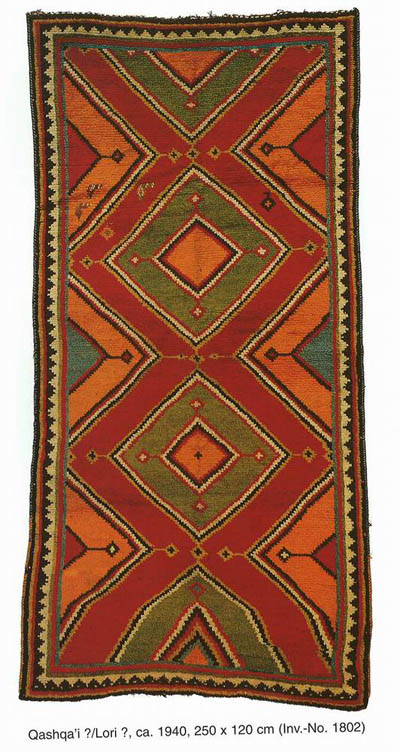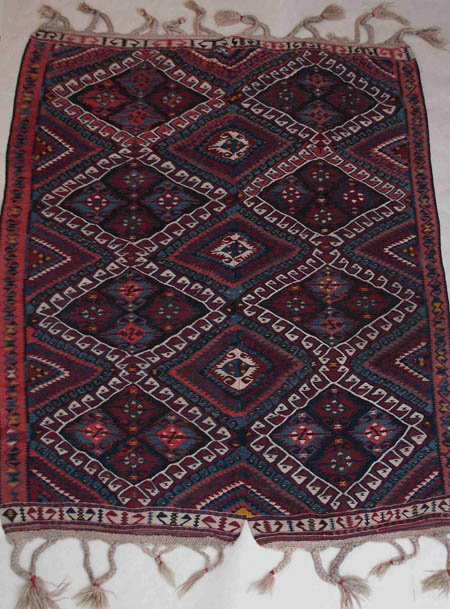Posted by louis_dubreuil on 02-20-2008 03:54 AM:
lurex lur ?
Bonjours à tous
I want to show you this gabbeh rug recently bought.
This rug mesures 154x80 cm. Long pile (about 1.5/2 cm), assymetric knot of three
threads made of two plyed yarns. About four shoots of wefts between each line of
knots. Thick undyed ivory wool warps. Supple handling.
The design is
typical of southwest Iran. The rug was sold as Shiraz, from Fars people, with a
design copied from the neighbours Yamaleh. For me it is typically Qashgai (or
lur ?). The design and the colour scheme is quite stunning.

The rug shows special
features : the back displays a stripped design due to the use of alternated
colours in the wefts. This decorative effect is reinforced by the use in the red
wefts of metallic threads I suppose being "lurex" (see picture).

I suppose that this
decorative effect on the rug back is justified by the fact that the rug in its
use (bedding ?) can be seen also from the back. There are known gabbeh with pile
design on both sides.
One other odd feature is the use for some single
wefts of litlle ribbons of cotton fabric (blue violet colour) in place of
threads of wool (in french "lirette" weaving).
I have seen this type of non
standard material in "boujad" rugs from Morocco. The similarities between
unregular moroccan rugs and gabbeh rugs from southwest Iran are numerous :
design, use (covers, bedding), non-commercial (at the origin) works, low time
consuming weanving process.
This can be explained by just a "convergence"
processus (same use and social context give similar weaving products) or by an
old artistic/technical common background among weaving nomad societies bringing
us back to the neolithic times.
Amitiés à tous
Louis
Posted by Richard Larkin on 02-20-2008 07:26 AM:
Great rug, Louis!
__________________
Rich
Larkin
Posted by Steve Price on 02-20-2008 08:21 AM:
Bonjour Louis
Congratulations on that terrific find. The metallic
thread makes me think of Kurdish weavings from the area around Lake Van, in
eastern Turkey. Interestingly, kilims made by Kurds in that region typically
have a field design of a column of diamonds, as your rug does. The colors are
very different, of course, and it's probably just a coincidence that your rugs
and Van kilims both have metallic thread and a related field design.
Regards
Steve Price
Posted by Jim Allen on 02-20-2008 11:58 AM:
Jim Allen
Here is something rather similar but from much further north. The seller of
this weaving said it originated in Zakatala. I just don’t know myself as I
haven't seen another similar piece.


Jim Allen
Posted by louis_dubreuil on 02-22-2008 03:41 AM:
lurex and a little rug game
Hello Jim
The back of your rug is more like a "tulu" than a
gabbeh;
Here are some ex of gabbeh from the books "gabbeh" (G.D BORNET,
TANAVOLI, AMANOLAHI). The design is of the same family than mine.
This
one on the left is labelled Qashgai or Lori


the second is labelled
Qashgai.
We can find the same design in flat weaves. For ex those two
gelims from the Azadi book "Persian falt weaves" :

Those latters are labelled Lors
.
Those different pictures do not help for precising the origin of my
rug. I think we can follow the dealer's indication : Shiraz market, Fars origin.
The indication Yamaleh design can be a reference to a Qashgai design , Yamaleh
or Amaleh being a Qashgai migrating tribe. In Fars region we can find Lur or
Qashgai tribes. So the rug can be a Qashgai/Lur Fars one.
In order to
illustrate the similarity in design between two foreign weaving cultures using
"irregular" style I have imaginated a little game.
Here are five rugs,
you have to find the gabbehs and the berber rugs among them.
rug
A

rug B

rug C

rug D

rug E

Good luck
Posted by Horst Nitz on 02-23-2008 04:11 PM:
Congratulations on that rug, Louis, it's a stunner.
Steve, maybe this
is the kind of kilim from the Van-Hakkari area you were thinking of.


Horst
Posted by Steve Price on 02-23-2008 04:37 PM:
Hi Horst
That looks like a kilim from the Lake Van to me.
Regards
Steve Price
Posted by Richard Larkin on 02-23-2008 06:23 PM:
Hi Jim,
I like your Zakatala. I have seen colors like this in
Anatolian weavings that I don't think are especially old. Do you know whether
yours is colored with natural dyes?
__________________
Rich
Larkin
Posted by Jim Allen on 02-23-2008 07:26 PM:
Zakatala
Most natural but some weird artificial ones as well. Fantastic wool and it
looks stronger in person than in my picture. I have it hanging in my third floor
apartment. Jim Allen
Posted by Chuck Wagner on 02-23-2008 09:19 PM:
Jim, et al,
Actually, the back of that piece looks a whole lot like an
Uzbek Julkhyr. I would have expected brown wool rather than an apparently blue
ground fabric.
Regards,
Chuck Wagner
__________________
Chuck
Wagner
Posted by Jim Allen on 02-23-2008 10:13 PM:
Zakatala
As far as I know all Julkhyrs look similarly from the back. It certainly
isn't Uzbek. I don't have any strong opinion about where it is from however.
Jim
Posted by danny mehra on 02-23-2008 10:43 PM:
Moroccan vs. Gabbeh
Louis,
Of the five rugs you posted in your quiz, I'd propose that A
and E are Moroccan, and B, C, D are Persian gabbehs. Is that
correct?
Cheers
Danny
Posted by Filiberto Boncompagni on 02-24-2008 02:34 AM:
QUIZ
(Of course, moderators cannot participate because it would be
unfair.
Filiberto)
Posted by Horst Nitz on 02-24-2008 03:06 AM:
Hi all,
A +C have no side borders proper, so this might be a criterion
for guessing them Berber. They were very popular in the 1960'ies through to
70'ies together with teak furniture with my parents' generation - so, after this
trend declined and if the Marrocan industrie should have chosen to give Berber
rugs a Gabbeh appeal at the time the latter were on the way up - they all might
be Berber Gabbeh.
Horst
Posted by louis_dubreuil on 02-26-2008 11:36 AM:
berber/gabbeh quiz
and the winner is ......Danny.
rug A Boujad rug circa 1940 (216x160
cm), from AZETTA page 151
rug E Ait bou Ichaouen circa 1900/1920 (505x210
cm), from AZETTA, page 140
rug B Lori , Mamasani, circa 1970 (187x111)
from Tanavoli GABBEH, page 110
rug C Qashgai circa 1980 (183x104 cm) from
Bornet GABBEH, page 54
rug D Lori, Mamasani, circa 1980 (182x139 cm)
idem, page 55
As Horst has noticed, berber rugs of this type generally
have no borders at all, or just an irregulary crenelated black
selvage.
Berber rugs are older than gabbeh
ex.
Amicalement
Louis
Posted by Chris Countryman on 02-26-2008 09:38 PM:
New view
Could someone please post Louis' beautiful rug sideways? The image is too
long to see it all at once on my monitor.
Thanks
Posted by Steve Price on 02-26-2008 09:47 PM:
Hi Chris
If I just turn it sideways it won't fit on most monitors
without scrolling sideways, and scrolling will be needed to read the lines of
text when that happens. So, I just made the image smaller for this post. Here it
is:

Regards
Steve Price














